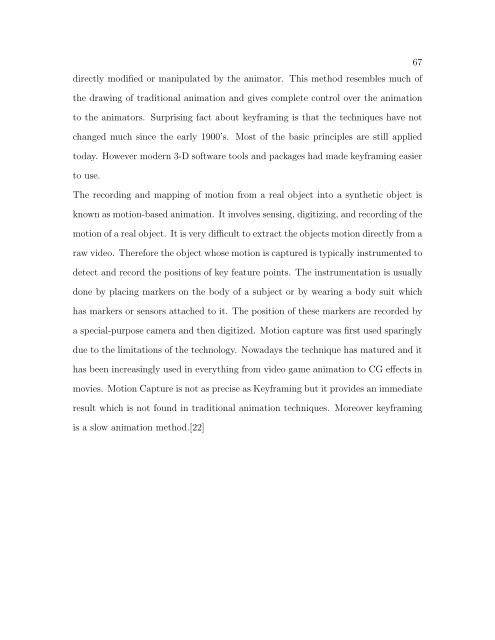A COMPARISON AND EVALUATION OF MOTION INDEXING ...
A COMPARISON AND EVALUATION OF MOTION INDEXING ...
A COMPARISON AND EVALUATION OF MOTION INDEXING ...
You also want an ePaper? Increase the reach of your titles
YUMPU automatically turns print PDFs into web optimized ePapers that Google loves.
directly modified or manipulated by the animator. This method resembles much of<br />
the drawing of traditional animation and gives complete control over the animation<br />
to the animators. Surprising fact about keyframing is that the techniques have not<br />
changed much since the early 1900’s. Most of the basic principles are still applied<br />
today. However modern 3-D software tools and packages had made keyframing easier<br />
to use.<br />
The recording and mapping of motion from a real object into a synthetic object is<br />
known as motion-based animation. It involves sensing, digitizing, and recording of the<br />
motion of a real object. It is very difficult to extract the objects motion directly from a<br />
raw video. Therefore the object whose motion is captured is typically instrumented to<br />
detect and record the positions of key feature points. The instrumentation is usually<br />
done by placing markers on the body of a subject or by wearing a body suit which<br />
has markers or sensors attached to it. The position of these markers are recorded by<br />
a special-purpose camera and then digitized. Motion capture was first used sparingly<br />
due to the limitations of the technology. Nowadays the technique has matured and it<br />
has been increasingly used in everything from video game animation to CG effects in<br />
movies. Motion Capture is not as precise as Keyframing but it provides an immediate<br />
result which is not found in traditional animation techniques. Moreover keyframing<br />
is a slow animation method.[22]<br />
67
















